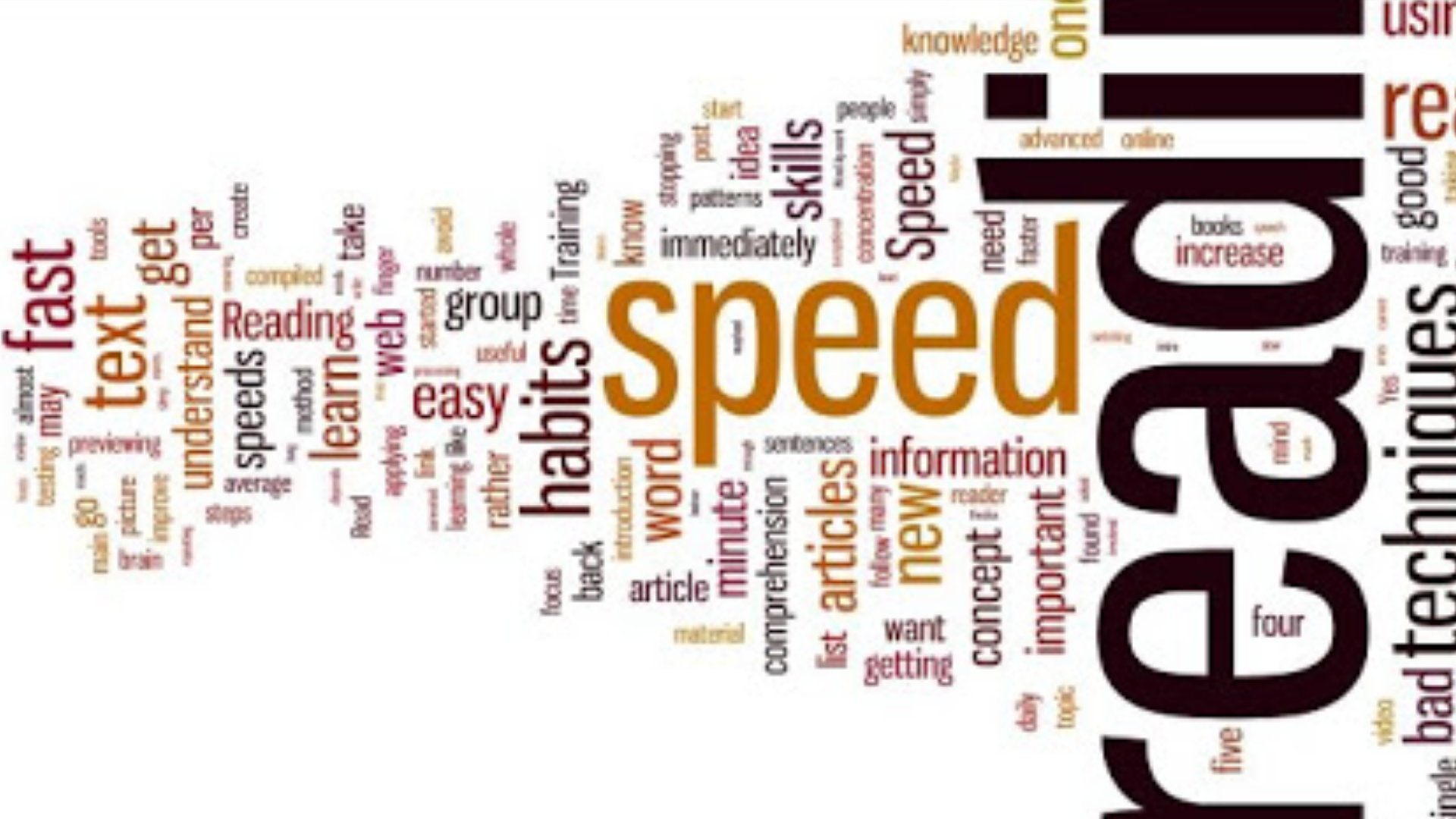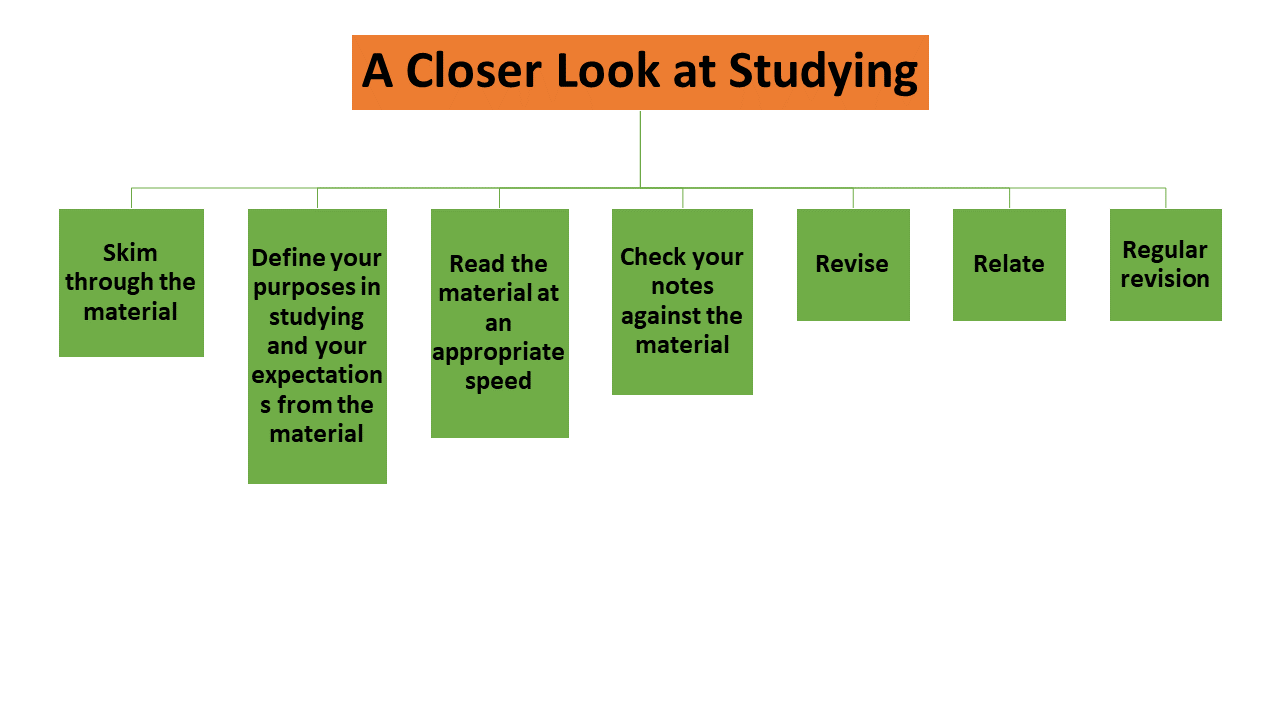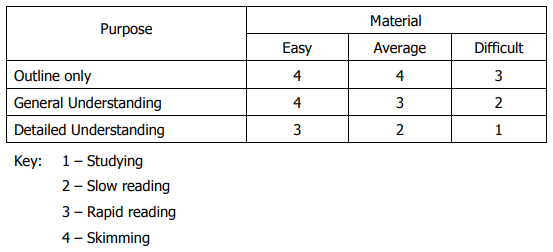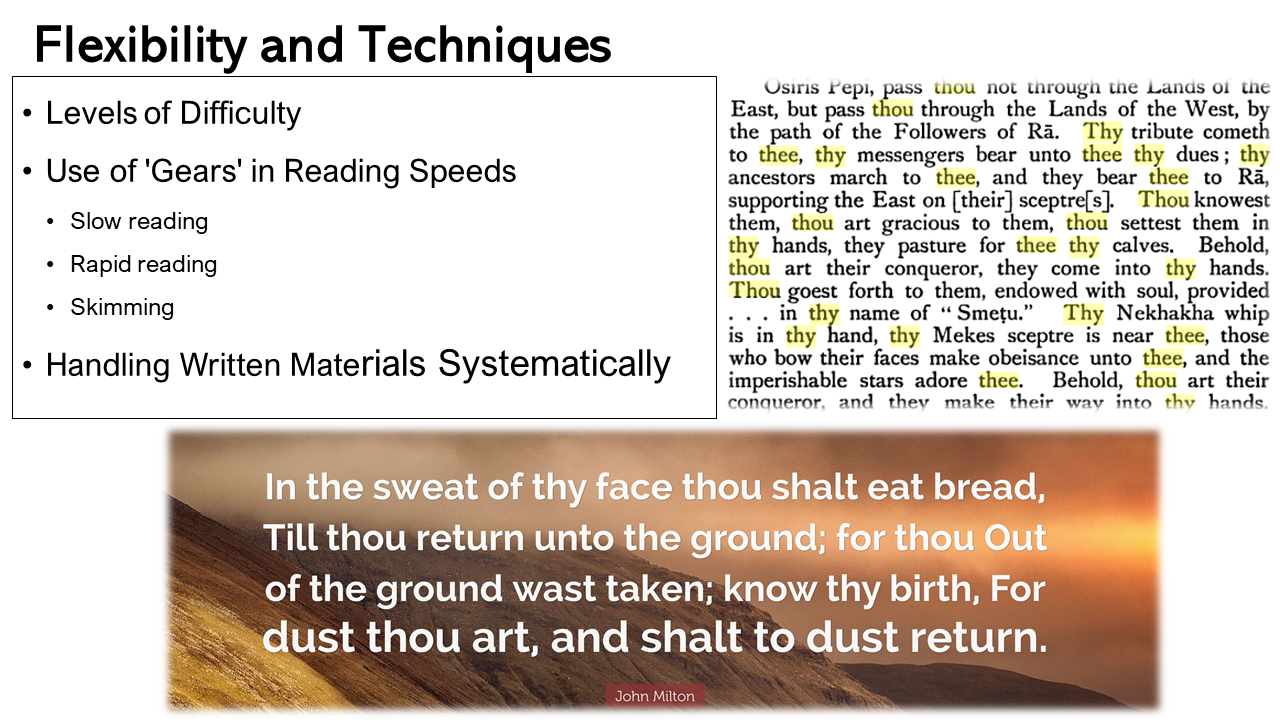Levels of Difficulty
No one would suggest for a moment that, in learning to become faster and better readers, we should allow ourselves to fall into the habit of reading everything we encounter at the same high speed. We must take into account not only our purposes in reading but also of the nature and level of difficulty of the material itself.
There are several factors, which determine the level of difficulty of any particular piece of material for any individual reader, and we must be aware of them if we are to approach our reading in a flexible and efficient manner.
Firstly, there is the effect of vocabulary. If the vocabulary used by a writer is wide and varied or if he uses many highly specialised or technical terms, this can make the material more difficult to read. The possession of an extensive vocabulary is therefore essential to the really efficient reader if he is to overcome this problem.
Some subjects are inherently more difficult to understand than others, especially those concerned with abstract ideas, so the subject matter must be taken into account. Similarly, some subjects are inherently more interesting than others, especially those dealing with human life and experience, like true-life adventure stories and biographies of famous people. The interest value of the material, then, is the third factor to consider.
As we have already said, our purpose in reading the material can contribute towards making things easier or more difficult to read. There are comparatively few purposes for which perfect comprehension is essential, but where it is required this makes reading more difficult. Moreover, what you hope to obtain from the material should coincide with what the material is offering, otherwise, difficulties will arise.
The construction of the material is important. A writer must at least be competent in expressing what he has to say, otherwise, he creates difficulties for the reader by, for example, poorly organised material or insufficient care in the choice of words. To a significant extent, efficient reading depends upon effective writing and this is particularly true with difficult subjects.
The layout of material affects the efficiency with which we can read it and here printers and publishers have a responsibility to fulfil. Typographical design, the length of the printed line, the quality and the colour of the paper can all raise or lower the level of difficulty for the reader. Duplicated material can be especially difficult to read because the information is frequently crammed onto a sheet of paper in an attempt at the economy.
Internal and external distractions at the time of reading, in the form of noise or people moving about, or even one's attention momentarily wandering from the task of reading, can affect one's concentration and thus make the material more difficult to read. Even the individual reader's personality can make the material more difficult. Some people are naturally capable of becoming interested in almost everything, others tend to specialise, and the degree of interest on the part of the reader (as opposed to the interest arising out of the material itself) can raise or lower the level of difficulty. Wide and varied reading interests can help to overcome this problem to a large extent.
Before deciding how much time, attention and effort a reading task requires it is, therefore, necessary to decide whether you expect the material to be easy, of average difficulty or difficult to read. During the coming week, you should pay particular attention to this aspect of the reading process in your efforts to select the most suitable technique for each piece of reading matter.
Use of 'Gears' in Reading Speeds
Flexibility involves making a conscious and deliberate choice of the most appropriate reading technique or 'gear' and, in fact, reading matter can be handled in one of four ways. It can be studied, read slowly, read rapidly, or skimmed. Whichever technique is the most appropriate on any particular occasion will depend partly upon your purpose in reading and partly upon the nature and level of difficulty of the material.

Briefly, the four 'gears' in reading speeds may be described as follows:
STUDYING involves reading, re-reading, making notes and giving careful consideration to the full meaning and implications of the material. Quite obviously, this takes time. It is, therefore, a technique to be reserved for those occasions when the content of the material is difficult or unfamiliar and/or the material is sufficiently important for the high quality of comprehension to be required. Speeds in study reading will range from a few words per minute (where a short passage is read several times, for example) to a maximum of about 200 w.p.m.
SLOW READING is, for most people who have no reading efficiency training, normal reading and is carried out at speeds ranging from 150 words per minute to 300 words per minute, approximately. The efficient reader uses slow reading where the material is fairly difficult or unfamiliar and/or a higher quality of comprehension than usual is required.
RAPID READING is the technique, or 'gear', which most adult readers are able to use for most purposes after a period of training such as the one provided in this book. It enables average or easy material to be dealt with at a comprehension level of 70-80 per cent, which is quite adequate for most purposes in reading. Speeds range from about 300 to about 800 w.p.m.
SKIMMING involves allowing the eyes to move quickly across and down the page, not reading every group of words or even every line. Effectiveness in skimming is greatly assisted by a clear sense of purpose, by paying particular attention to headings, sub-headings, the opening and closing sentences of paragraphs and by looking for keywords and phrases. It is a suitable technique when a general outline, or 'overview', of the content of the material, is required (800-1000 w.p.m.) or when the reader is trying to locate specific facts or ideas (1000+ w.p.m.). You have already begun to practise a form of skimming in your previewing of material before you read it and in your reviewing of material after having read it.
Since you will already be quite familiar with the technique of slow reading and since you are gradually developing the ability to read rapidly in your progress through this book, let us take a closer look at the techniques of skimming and studying.
A Closer Look at Skimming
Skimming, then, is a form of very fast 'reading'. Your eyes move quickly across and down the page, seeking out the important information that the writer is trying to communicate and discarding everything that is of secondary or minor importance. It can be used profitably when you are reading for specific details (we all skim when 'reading' a dictionary or a telephone directory) or are looking for certain keywords and phrases (for example, when skimming a journal article to ascertain the level at which the writer is treating his subject).
Skimming, therefore, is not reading in any normally accepted sense, but it is still a valid reading technique that can be used to obtain information from the printed page. Skilled skimmers find that they have to read infill only difficult or important material, everything else can be skimmed without appreciable loss incomprehension. You will need to practise a great deal, however, if you are to emulate these natural skimmers. With practice, students have been known to skim at 2000 w.p.m. and even 3000 w.p.m. and still score highly on the kind of comprehension test in this book.

As you practise skimming, look for the main points the writer is making or for the answers to certain questions about the material which may be at the back of your mind. (What is he saying that is useful to me? What evidence does he give to support his statements?) Remember that you are here transferring the techniques that must be used to find information in dictionaries, telephone directories, handbooks and encyclopaedias to other types of material to acquire certain information only.
When you are skimming, make the fullest possible use of the headings and sub-headings provided and be particularly aware of key or 'topic' sentences in paragraphs. When you have the information you need, move on quickly. Pace yourself against the clock, just as you have been doing on the reading exercises in this book. Check your comprehension by noting down the main points and checking these afterwards against the material. If you require a more specific comprehension test, then practise skimming on some of the earlier passages in this book that you do not recall so clearly now. You can use newspapers, journals, reports and books for additional practice. You will also find some skimming exercises at the end of this chapter.
As you develop your skill in skimming you will find you are benefiting considerably from the other material the savings in time enable you to read and from not having your attention occupied by unimportant or irrelevant material. At first, you may notice some apparent loss incomprehension, but, with a few days' practice, this will correct itself. After all, you are very probably skimming already when you read your daily newspaper (or do you read it all, even the advertisements?) All you are being asked to do here is to realise that there are many more occasions on which you can skim, and, providing you really know your purpose in reading, still, understand the material well.
A Closer Look at Studying
We have already defined studying briefly but since it is a fundamental reading technique and since most people are unable to study effectively without instruction we shall now discuss it a little more fully.

As we have already said, studying involves reading and rereading material, making notes and giving careful consideration to the full meaning and implications of the material. It is important to remember that, whilst this process takes time and no little effort it usually results, in the long run, in savings in time. If material is sufficiently important or difficult to require studying, any attempt to find a shortcut by being content simply to read the material will invariably result in the necessity for reading it again at a later date. If the material has been studied properly and methodically in the first place, the most you should normally have to do is to refer to your notes.
We all recognise this fact when we are studying for an examination and it is surprising, therefore, that we should fail to recognise that some of our reading at work poses similar problems to those which the examination student's reading poses. After all, if a report, for example, is to be analysed and evaluated at a meeting, this is very similar to an examination situation. On many such occasions, it is we, as well as the material, who are being examined on our abilities to reach effective decisions and conclusions by our colleagues or our superiors. we cannot afford to treat such a situation lightly.
To read effectively for study purposes, you should first skim through the material to obtain an 'overview', or general idea of the contents. Secondly, you should define your purposes in studying and your expectations from the material as clearly as possible. You will be familiar with the nature of both these steps from your work on previous chapters in this book.
The third step is to read the material at an appropriate speed, marking important words, phrases, sentences and paragraphs or noting their substance in a notebook. This is the longest, and to many readers the most irksome, stage of the study process, but it is inevitable if the material is very important or difficult to understand. It is this stage that most readers are tempted to omit in the belief that they can obtain a high level of comprehension without it. Or it may be left out because of laziness. Whatever the reason, its omission invariably leads to having to read the material in full a second time or to suffer the consequences of lack of comprehension of the material.
The fourth step is to check your notes against the material to see that nothing of importance has been missed and to make sure that your notes are an accurate and sufficient summary of the material. This check is most important if you are to have the confidence that when reference is made to the material in future, you need only, on most occasions, refer to your notes and do not have to re-read the material all over again. It is important that each step in the study process is completed conscientiously if the maximum benefit is to be derived from this reading technique.
On many occasions and for many purposes in reading, there will be three further steps that must be incorporated in the processes of studying. Frequently, you will need to revise the notes you have made or the passages you have marked for special attention to ensure that your grasp of the material remains of a high order. If this is so, you will find that the need for revision is reduced if you get into the habit of revising your notes the same day on which you made them. If you are studying in the evening revise your notes early the next day. You will find that this kind of immediate revision is an effective method of fixing the material more permanently in your mind.
You will also be well advised to attempt to relate what you have read and learned to its context in the problem being tackled, the work being done or the subject being studied and to what has been learned from previous reading and experience. Try to see connections wherever they exist and in this way, you will build up mastery of the subjects you study and establish a firm foundation for your future reading.

With the most important and the most difficult material you have to deal with, you may find it necessary to add a final step in the form of regular revision of your notes. This is particularly true if you are studying material for, say, a high-level policy meeting or some kind of examination. For complete mastery, you need to follow revision done immediately after reading and your attempts to relate what you have read to your previous knowledge with continuous and progressive revision until you are thoroughly familiar with the material. Regular revision is another aspect of study reading which is frequently neglected and particular attention should be given to this. You will find that if you have followed all the previous steps in the study process then revision becomes much easier and is carried out quicker. Revision only becomes difficult and time-consuming when you have not carried out the other steps in the process.
Handling Written Materials Systematically
One of the basic inefficiencies of the slower reader is that he tends to read slowly all the time. Flexibility is the key to efficiency in reading. Not every piece of writing is of equal importance and some require much more time, care and effort than others. You should reserve your energies for more demanding material. To encourage flexibility and the intelligent use of 'gears', ask yourself the following questions:
- Am I spending enough, or too much, time reading this material?
- Am I taking enough, or too much, care over my reading on this occasion?
- Am I making enough, or too much, effort to understand what I am reading?
As a general principle, the efficient reader will read everything as quickly as his purpose, the material and conditions permit. Thus, he is assured that at any time he is reading as efficiently as he is capable of reading. To achieve the kind of systematic flexibility required, you should also ask yourself, every time you read:
Am I reading as quickly as my purpose, the material and conditions permit?
Is there anything I should be doing in order to read more efficiently?
Am I ready to speed up or slow down if the material suddenly becomes easier or more difficult or if my purpose in reading it changes?
You should never be 'just reading', except when you are using reading merely as a time-filler.
By being flexible, you improve your ability to handle written materials systematically and to make the best possible use of the reading techniques or 'gears' open to you. The following table gives an approximate guide to the kind of reading situation in which each of the four 'gears' is usually used by efficient readers.

Of course, you are the only person who can make the final decision about how to deal with a particular piece of reading matter. You may find that, for most purposes in reading, the preview-read-review approach is quite adequate.
Developing Flexibility
The passage which now follows will provide you with greater opportunities than the previous exercise for developing your flexibility in approaching reading materials and for doing this systematically along the lines we have discussed in this chapter.
The passage will require you to summarise the content and this should enable you to avoid trying to 'spot' possible comprehension questions, leaving you free to put the principles of flexible, efficient reading into practice.

